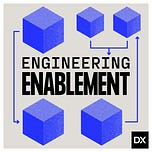Listen and watch now on YouTube, Apple, and Spotify.
In today’s episode, I’m joined by Laura Tacho, CTO at DX, engineering leadership coach, and creator of the Core 4 framework.
We discuss why many frameworks—such as SPACE, DORA, and even Core 4—can go awry when teams focus on the wrong metrics. We explain how to get started with Core 4 by anchoring on controllable inputs rather than arbitrary targets. Whether you're just beginning with metrics or trying to course-correct a bloated system, this is a sharp, practical guide to implementing Core 4 in a way that actually works.
Some Takeaways:
Common pitfalls with engineering metrics frameworks
Frameworks like SPACE, DORA, and Core 4 often fail when implemented without clear context.
Teams sometimes adopt metrics haphazardly, setting targets that don’t align with their specific challenges.
Some metrics may be irrelevant for certain teams—or easily gamed.
Metric overwhelm is common: tracking too many metrics leads to confusion and dilution of focus.
Leaders often fail to communicate why specific metrics are chosen or how they tie to business goals.
Goodhart’s Law: “When a measure becomes a target, it ceases to be a good measure.”
Teams may distort or manipulate metrics to hit arbitrary goals.
Example: Reducing bug counts as a target can lead to underreporting rather than real quality improvement.
Input vs. output metrics
Input metrics are actions teams can directly control (e.g., time spent on new capabilities).
Output metrics (e.g., delivery speed, reliability) are influenced by many factors and harder to manage directly.
Focusing on inputs gives teams a clearer path to improvement without encouraging unhealthy behaviors.
How to implement Core 4 well
Start small—track a few metrics first before expanding.
Don’t set targets until you’ve established a baseline and understand what’s realistically controllable.
Aim for the 75th percentile to push for improvement while avoiding unrealistic pressure.
Use metrics to create a culture of reflection and continuous improvement, not judgment.
How to avoid gamification
Use multidimensional metrics to avoid tunnel vision.
Focus on input metrics.
Reward effort, learning, and progress—not just hitting numeric goals.
Include teams in the goal-setting process to increase buy-in and reduce manipulation.
Give teams space and time to make real progress.
In this episode, we cover:
(00:00) Intro: Improving systems, not distorting data
(02:20) Goal setting with the new Core 4 framework
(08:01) A quick primer on Goodhart’s law
(10:02) Input vs. output metrics—and why targeting outputs is problematic
(13:38) A health analogy demonstrating input vs. output
(17:03) A look at how the key input metrics in Core 4 drive output metrics
(24:08) How to counteract gamification
(28:24) How to get developer buy-in
(30:48) The number of metrics to focus on
(32:44) Helping leadership and teams connect the dots to how input goals drive output
(35:20) Demonstrating business impact
(38:10) Best practices for goal setting
Where to find Laura Tacho:
• LinkedIn: https://www.linkedin.com/in/lauratacho/
• Website: https://lauratacho.com/
Where to find Abi Noda:
• LinkedIn: https://www.linkedin.com/in/abinoda
Referenced:











